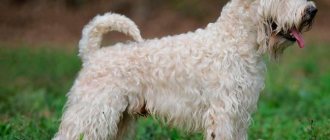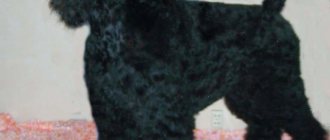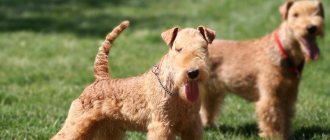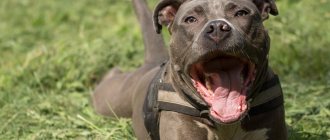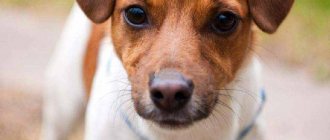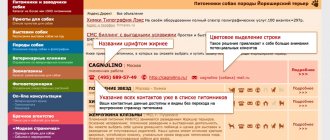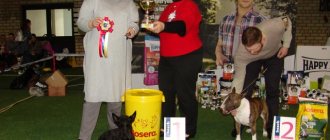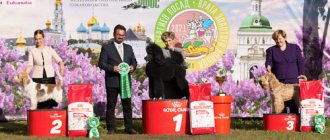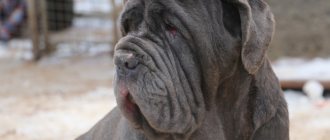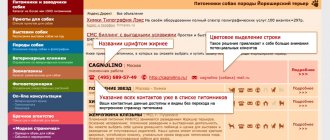Breed rating: Intelligence Trainability Popularity Security Cheerfulness Playfulness Observation Child-friendly Ability to train 0 reviews and comments
The Wheaten Terrier is a true representative of Ireland. This is an active, lively and determined dog with a beautiful exterior. Despite its small size, it is a popular breed. In our country you can buy a furry friend with fur the color of ripe wheat.
Gryuspin dog kennel. Irish Soft Coated Wheaten Terrier
| Description: | Our dogs actively participate in exhibitions and are multiple winners both in Russia and abroad. They are also successful in sports competitions: agility, skipulling, skijoring. We are happy to participate in fun competitions along with other dog breeds. All our producers are tested for health and are free from severe genetically inherited diseases. We carefully select pairs for mating and strive to obtain quality dogs in our breeding. Our motto is “quality, not quantity”. |
| Contacts: | +7-916-906-94-59 Maria |
History of the origin of the species
The history of the development of the breed does not have any documentary support. The Irish themselves claim that terriers existed even before the return of St. Patrick, in the 4th-5th century. But dogs were registered in the 19th century.
The dog was popularly nicknamed the “red little devil” because of his rebellious, mischievous character.
The closest relationship to Irish Terriers is the Wirehair. They were bred to hunt burrowing animals and small rodents. Until 1870, different terriers were bred in different counties: body proportions and colors differed. The Antrim region represented brown, white and black dogs; Whiteley - reddish; Iverakh - black and brown.
But after 1879, when a breed club was opened in Dublin, the breed standard became clearer. Only medium-sized red dogs were now allowed for breeding. The popularity of terriers grew by the 1920s. But because of the war, interest in the Irish disappeared.
A lover of the breed, the owner of a trading company, was not indifferent to the fate of the Irish Terriers. Therefore, he carried out an action to popularize animals, thereby saving the number of livestock. But it was not possible to bring dogs to leading positions in Britain.
Kennel of dogs "Mariol". Irish Soft Coated Wheaten Terrier
Take the Attention Test! Find 10 differences! (click right here!)
Find the answer Are you bothered by some problem or question? Enter “Breed” or “Name of the problem” into the form, press Enter and you will find out everything about the issue that interests you.
| Description: | The Mariol special breed kennel deals with Irish Soft Coated Wheaten Terriers. In the kennel there are dogs with different types of coat. We strive to ensure that our kennel produces balanced dogs with good health that meet the standard. |
| Contacts: | +7 905 739 4290 |
How to choose a puppy
The main problem when choosing an Irish Terrier puppy is the shortage of registered kennels, so sometimes you almost have to stand in line to buy babies.
- Irish Terrier puppies are distributed at 2-2.5 months, but it is better to get acquainted with them earlier, for example at 4 weeks of age.
- Evaluate the bitch's reaction to your arrival. If the dog tries to gather the cubs into a pile and cover them with his body, this is normal. Obvious cowardice and aggression towards a stranger is an alarming signal.
- The exhibition potential of Irish Terrier puppies reveals itself approximately in the fifth month of life, so if you are planning to get a show-class animal, delay the purchase longer.
- When a stranger appears, puppies should not run away as fast as they can. This suggests that the animals are raised in isolation and do not have contact with anyone other than the owner of the nursery.
- The right Irish Terrier puppy is sociable and responsive to affection. He willingly goes into his arms, exposes his belly for scratching, and allows himself to be touched.
Dog kennel Laimberg. Irish Soft Coated Wheaten Terrier
https://dog-care.ru/porody/pitomniki/sobak-irlandskiy-myagkosherstnyy-pshenichnyy-terer-v-moskve.html
| Description: | The kennel is engaged in breeding Irish Soft Coated Wheaten Terriers. The kennel has its own groomer and handler, and provides comprehensive support to the owners of our puppies |
| Contacts: | icq 222488260 89162340145 |
Breed characteristics
| Short description | |
| Origin: | Ireland |
| Conditions of detention: | House, local area, apartment |
| Purpose: | Hunting dog, companion, guard |
| Color: | Wheaten, red (ears are always darker) |
| Wool length: | Medium, curly |
| Adult dog size: | Height at the withers – 46-48 cm, weight – 11-12 kg |
| Average life expectancy: | 13-15 years old |
| Walk: | Walking twice a day is required |
| Physical activity needs: | High physical activity needs (walking and jogging and regular exercise) |
| Fédération Cynologique Internationale (FIC) classification: | Group 3: Terriers, Section 1: Large and Medium Terriers |
| Puppy price: | Without pedigree - up to 20 thousand rubles, pet class - 22-24 thousand rubles, 30 thousand - breed class, show class - from 35 thousand |
Dog kennel Sunny Flame. Irish Soft Coated Wheaten Terrier
| Description: | SOFT COATED WHEATEN TERRIER puppies for sale. From parents of champions. The temperament of wheat is unique. Fast, lively and gentle, the dog retains puppy cheerfulness and energy at a high level throughout its life. Wheaties are balanced and cheerful, less pugnacious than most other terriers; they are a kind, loyal and funny dog. Watching the wheat will make you smile all the time. Wheat is an excellent companion, athlete and simply handsome with excellent health and a stable psyche! The dogs have silky flowing wavy wheat-colored hair, do not shed, and do not smell like a dog. Vaccinated according to age. Mother: Galatea Sunny FlameTitles: Junior Champion of Russia, Champion of Russia, Champion of Belarus, 3 Candidate for RFSS Champion, Candidate for OANKOO Champion, 6x Best of Breed, 13x Class Winner, BIG - 1, BIG - 2, BIG - 3, BIG - 4 Father: Inflorescence Absolute WinnerTitles: Champion of Russia, Junior Champion of Russia, Junior Champion of the National Breed ClubRes. CW at the 2008 World Championships! |
| Contacts: | 89265106453 |
Distinctive features
Dogs of this type must meet the requirements of the FCI standard, which defines the following parameters:
- The eyes are a rich dark brown shade. They are medium in size, not flat, but not convex either.
- The head has a flat skull of moderate width, not coarse. The leg is clearly visible. The muzzle is approximately equal in length to the skull. Cheekbones are slightly emphasized.
- The bridge of the nose is large and always black.
- Leg with well-developed bones and muscles. The angles of the knee joint and scapula are well defined. The hip joints are not turned out or raised high. The feet are small with dark claws.
- The bite is scissor-shaped, although a straight bite is allowed. The jaws are strong with large teeth.
- The neck is strong, of normal length, not “wet”.
- The body is approximately square, with a strong and straight back, shortened loin. The sternum is wide with rounded ribs.
- The ears are small, set back up, folded down and erect at the level of the skull line. The ears should not wag when walking, but should lie flat.
- The tail can be natural or trimmed to one third of the length. The tail is usually raised, but does not fall over the back.
- An adult dog's coat is soft, but not fluffy like a poodle's, and is of medium length and covers the muzzle. It has a characteristic coarse wavy or wavy pattern and is devoid of undercoat (except for the tufts near the inner ear). It is allowed to show dogs after trimming or in their natural state.
In the first case, the hair is left at a natural length above the eyes, in the area of the mustache and chin, on the limbs, and on the body it is lightly striped to emphasize the figure. The neck, chest, skull and tail are shortened. All shades of wheat can be dyed; the inside of the ear may be darker. The texture, length and color of the coat are finally formed at the age of 18-24 months.
Before adopting a dog from the kennel
Any pet with character and emotions. Call a friend who already has an animal if you have not interacted with animals. Relatives may have a negative attitude towards the decision to adopt a dog - convince them and get their consent. Walk the dog yourself, or arrange with relatives. Remember, the dog is usually walked 3 times a day. If you have children, they should be able to get along with animals. Teach them not to hurt your pet. The child should not touch the pet when she is eating or sleeping. You cannot scare or shout at the animal.
Education and training
The learning abilities of Irish Terriers are, if not phenomenal, then very impressive. The only problem is to awaken the animal’s desire to exercise. Experienced dog handlers advise relying on the breed’s natural curiosity and interest in new activities. A dog will move mountains for company with its beloved owner, especially if the owner is not too lazy to diversify the learning process with playful moments. On the other hand, it is better not to slip into open familiarity with representatives of this family. Irish Terriers are aware of what leadership is and are very eager for it. If the “Irish” is the only pet in the house, then, in the absence of more suitable competitors nearby, he will willingly compete for spheres of influence with his own owner.
You will have to select a training program for the Irish Terrier depending on the type of activity the animal performs. For example, a course for search and rescue dogs is very different from the set of classes that guard dogs attend. As for sports training, with Irish terriers you can master coursing, agility, frisbee dog and skijoring. Today's "Irish" are rarely seen hunting, but this is more likely due to the unpopularity of the breed as a whole than due to lost stalking skills. If necessary, train a dog to work on a blood trail, fishing out a shot bird from a pond and its subsequent removal is a completely doable task.
It is better not to delay training and education of the dog, because in the first months of life, Irish Terrier puppies are more pliable, more obedient, and the owner is still an indisputable authority for them. So, grow up your ward a little and start learning the basics of OKD. By the way, training in the classical form will not suit the “Irish”. Animals consider it beneath their dignity to carry out a command only because a person demands it. Typically, breeders recommend talking more with their pets, explaining to them the appropriateness of this or that requirement. It is also not prohibited to take your Irish Terrier to training grounds, but you cannot count on outstanding success from the training. Red-haired cunning people quickly figure out what’s what and begin to evade the “obligation” in every possible way. Please note that this breed strives to work fully, and not for show, so it perceives any group classes as a useless performance.
It is believed that Irish terriers cope well with CSD, but it is important to soberly assess the situation. Due to its rather modest dimensions, the dog will not make a full-fledged security guard. However, if your goal is to scare away petty hooligans, why not try it. The main thing is that the pet responds quickly and correctly to the call. Do not forget that the Irish Terrier is a gambling dog, often getting into a rage and ignoring any external stimuli. It is optimal if it is possible to delegate the animal’s training to a professional who will develop an individual ZKS program for it. The fact is that the standard standards approved for service breeds will not suit the “Irish” - the build is not the same.
You should be extremely careful when punishing your pet. Of course, in raising any animal, you can’t do it with the carrot method alone, but in the case of Irish terriers, sometimes it’s better to turn a blind eye to a harmful trick than to cause negative emotions in the dog. Moreover, the breed has an excellent memory, and the “Irish” fixes all injustices in his consciousness for a long time. Accordingly, no matter how carefully and effectively you work with your dog, it will not be possible to train him to be an exemplary servant who automatically carries out any command. After all, this is not what Irish Terriers were bred for. It’s better to give your ward more freedom, and he will definitely respond to you with respect and diligence.
The first thing to do
Plan when you will take your dog for vaccinations. Bring toys for him to play with. Prepare a place and train your pet to this place. Necessary things:
- Dry food,
- clothes,
- Shampoo,
- Oral hygiene product,
- Brush (comb),
- Claw clipper.
If you want to add your organization, fill out the form below: Indicate the name of the nursery, its description and provide contact information. We will be glad to add you to our directory.
Maintenance and care
Irish terriers are not purchased to be chained and placed in a kennel. Of course, the breed did not become a completely decorative breed, but its working status has long been transformed into a sports companion. If we are talking about ideal dog housing, then for the “Irish” these are country cottages with a spacious fenced area. Moreover, it is better to place the fence higher - in a jump, terriers can overcome the 1.5-meter bar. The dog gets used to a standard apartment if the owner does not restrict the pet from walking and is not lazy to fully train with it in the park.
Hygiene
So that the Irish Terrier does not look like a neglected disheveled dog and does not lose its breed characteristics, it must be trimmed. Aerobatics is, of course, manual pinching. However, for beginners, such a technique is beyond reality, since even an experienced “tweezer” can take 5 or more hours to treat one dog. Therefore, if you have already decided to save on professional grooming, then at least stock up on a set of trimming knives, with which the procedure will be faster and easier. It is clear that in the absence of practice, the result of the first trimming is unlikely to be impressive, but the breed in the Irish Terrier should be guessed. In particular, trimming diagrams that clearly demonstrate pinching options on specific areas of the body will be a good help for a self-taught groomer.
Tools you will need to pinch an Irish Terrier:
- stripping;
- slicker brush;
- trimming knife;
- thinning scissors;
- wool clipper.
The first trimming is carried out at 2.5-3 months: the procedure helps rid the puppy dog of unnecessary plumpness and softness. The mustache and beard are usually left untouched, as are the legs, but to give these areas a neat appearance, the hair on them is lightly trimmed with scissors. The hairs in the ear canal are also plucked to ensure air circulation inside. As for the frequency of the procedure, show Irish terriers are plucked once every 1.5-2 months, and on the eve of the event they simply finish what they started to perfection. Pets can be trimmed once every six months, in the intervals between pinching, limiting yourself to standard combing of the dog’s hair with a brush.
Important: plucking is carried out only on clean, pre-combed hair that has been removed from tangles.
In principle, the Irish Terrier does not need regular baths, especially since in the summer representatives of this breed willingly splash in open water. If the dog is seriously dirty, a bath day will have to be arranged. Just use the correct shampoo for wire-haired breeds and do not let your pet outside until it is completely dry.
Caring for a dog's eyes and ears follows the classic scenario: systematic cleaning with a soft cloth moistened with a herbal decoction or cleaning lotion. You will have to tinker with the puppy’s ears additionally: in order to form the correct position, the ear linen is fixed with adhesive (adhesive) on a cardboard or plastic frame.
Your Irish Terrier's teeth should be sparkling white, so brush them once a week with a toothbrush or silicone brush, and let your dog chew hard treats. The Irish's claws are trimmed only when the need arises. For example, if a dog runs a lot on the street and actively trains, the keratinized layer will have to be trimmed about once every month and a half, or even less often.
Feeding
The Irish Terrier's diet is traditional: meat and offal, seasoned with cereal porridges, stewed or fresh vegetables, fruits and herbs.
Additional sources of protein for dogs include fermented milk products and boneless sea fish. Along with food, it is useful for the “Irish” to give vitamin supplements. Particular preference is given to calcium-containing supplements and complexes with chondroitin and glucosamine during the period when the puppy is growing rapidly. Dry industrial food is also a good option if it is a variety for medium-sized breeds of at least premium class.
